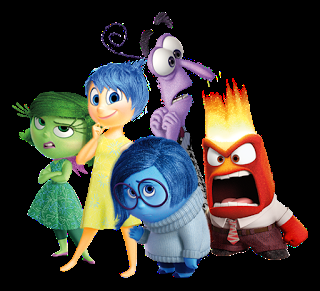For my family, Inside out is a very special movie not just because it has an amazing story line and teaching but because it was Arrow's first movie in a theater. Having watched it in 2015, it still lingers in my mind, curiously asking myself which emotion of mine is on the console today?
 The movie journey's through Riley growing up and how her experiences start forming memories of which some become core memories that in turn power aspects of her personality. While Joy's role is to ensure Riley’s happiness, fear keeps her away from danger, disgust allows her to make the right decision, anger is to keep things fair while sadness...well no one know what the role of sadness is. As an effort to keep Riley happy, Joy distracts sadness and limits her to a corner. Something which a lot of us do hoping we will be happy.
The movie journey's through Riley growing up and how her experiences start forming memories of which some become core memories that in turn power aspects of her personality. While Joy's role is to ensure Riley’s happiness, fear keeps her away from danger, disgust allows her to make the right decision, anger is to keep things fair while sadness...well no one know what the role of sadness is. As an effort to keep Riley happy, Joy distracts sadness and limits her to a corner. Something which a lot of us do hoping we will be happy.
Many a times, we too make the mistake Joy made. We bottle our sadness up, limiting it to a circle. We ignore it; we try to replace it with positivity, thinking it will go away. The problem is it does not work that way. We may succeed in masking it, pushing it deeper and deeper into our soul.
Riley's bottled sadness began showing up in different forms. She begins feeling easily irritated. She loses interest in hockey, snaps at her friend and father, lies and even runs away. Fear, anger and disgust start taking control. When feelings are ignored, buried deep down, or not allowed to be expressed, they push back harder and create the potential for explosion.
Soon Joy realizes no matter how much she tries, she cannot keep Riley happy all the time. Joy lets sadness play her part. While the movie revolves around Joy, it is Sadness that teaches us how all our emotions serve a purpose. Every feeling gives us information about our experiences, and about other people’s experiences. They clue us in to life’s challenges and rewards. They motivate us to connect with others, and to make changes in our lives. They keep us safe and they encourage us to take risks. We need all our feelings to make these things happen. We need all our feelings to stay healthy.
When Riley expressed sadness, her parents realized she needed more support. When Riley was allowed to feel sad without pressure to be any other way, and when she and her parents recognized her feelings, she was able to move forward, in a healthy way.
In the end, as Riley grew, we saw memories that were not so solidly blue, yellow, red, or green. The majority were not just yellow anymore either. And the memories that included blue were not viewed as negative. We saw memories with mixed emotions, ones that were red and blue, green and yellow. Riley’s Control Center helped her grow and learn that experiences aren’t assigned just one emotion and that all the emotions are helpful for her, even Sadness.
Have you ever found yourself controlled by a particular emotion? Have you ever stopped for a moment to ponder which is the emotion that has built your character? Or do you let every emotion play its part? I know a person who is addressed as "happiness" and I know a person who is addressed as "Rotal" (Hindi for cry-baby). Both of them amazing personalities.
If you haven't watched the movie, I encourage you to do so. You can read the review on IMDB
